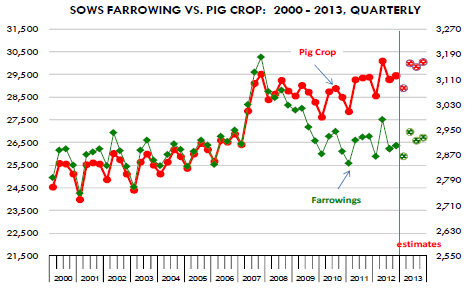



CME: Total March Hogs & Pigs Inventories Expected to be Higher
US - In addition to two very important grain reports (see DLR 3/26), USDA will also release on Thursday (3PM ET) the results of its quarterly survey of hogs and pigs inventories as of 1 March 2013, write Steve Meyer and Len Steiner.On average, analysts expect total hogs and pigs inventories as of 1 March to be 0.7 per cent higher than the previous year. The total inventory of hogs and pigs on the ground is a function of the number of pigs that were added to the overall inventory on 1 December (pig crop, imports) and the number of hogs and pigs that were removed (slaughter, death loss).
So far the balance sheet tends to be close to the average of analysts estimates, although much still depends on key assumptions, especially about the size of the pig crop in the past quarter.
Analysts expect the pig crop for the December through February quarter to be 1.2 per cent larger than the previous year, an increase that adds about 350,000 head to the available supply for the quarter compared to the previous year.
One caveat in this regard is that this assumes no revisions to previous year’s numbers. The pace of hog imports from Canada was notably slower this year compared to the year before and that will reduce the number of hogs that entered the total hog supply for the quarter.
Weekly data from USDA shows that for the period December through February, total hogs and pig imports from Canada were down about 9.5 per cent from a year ago. This will help offset about a third of the gains in the pig crop.
Then there is the issue of hogs that were removed during the quarter. Based on the USDA monthly slaughter statistics, hog slaughter for the period Dec-Feb was 28.019 million head, down 1.8 per cent from a year ago. Using these inputs and also accounting for a normal death rate, one can see why hogs and pigs inventories as of 1 March 2013 are expected to be larger than they were the previous year. Again, keep an eye on those USDA revisions of prior quarters and especially on the farrowing numbers for the Dec - Feb quarter.

The industry has benefited in recent years from improvements in productivity, with the number of pigs per litter steadily increasing. While the pace is expected to slow down, especially as group housing is adopted more broadly, the expectation is for litter size to continue to expand, probably at a rate of about 1-1.5 per cent for the remainder of the year.
This is important when considering the analyst estimates for Mar-May and Jun-Aug farrowing intentions. On average, analysts expect farrowings for Mar - May to be down 1.3 per cent from a year ago. Even with more pigs per litter, it is possible that the pig crop for the quarter could be down compared to the previous year.
That decline combined with higher expected slaughter (see market hog inventory expectations below) and fewer hogs coming from Canada, implies that by 1 June we could have total hog inventory that is smaller than it was on 1 June 2012.

The breeding herd estimate is for only a modest increase compared to previous quarter (about 20,000 head) and also a modest gain on year ago levels. Female slaughter so far this year has been running below year ago levels.
According to the latest data from University of Missouri, year to date sow slaughter is down 1 per cent while gilt slaughter is down 3.5 per cent from a year ago. Sow prices have increased sharply in recent weeks, another indication that producers are gearing up for lower feed prices and higher production in 2014.








